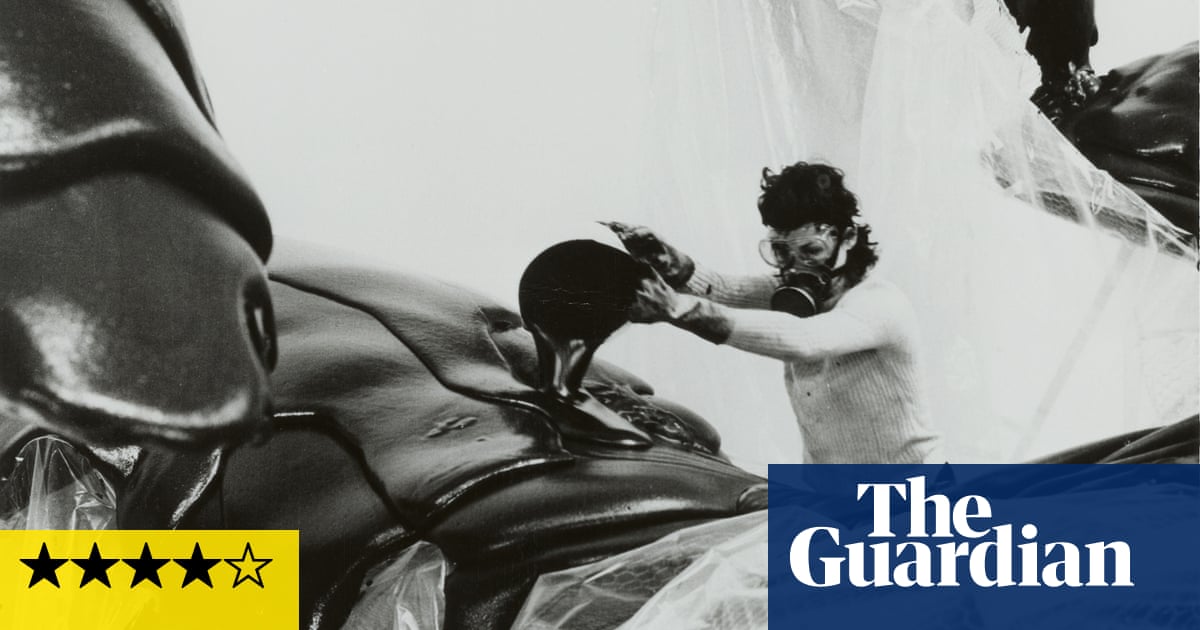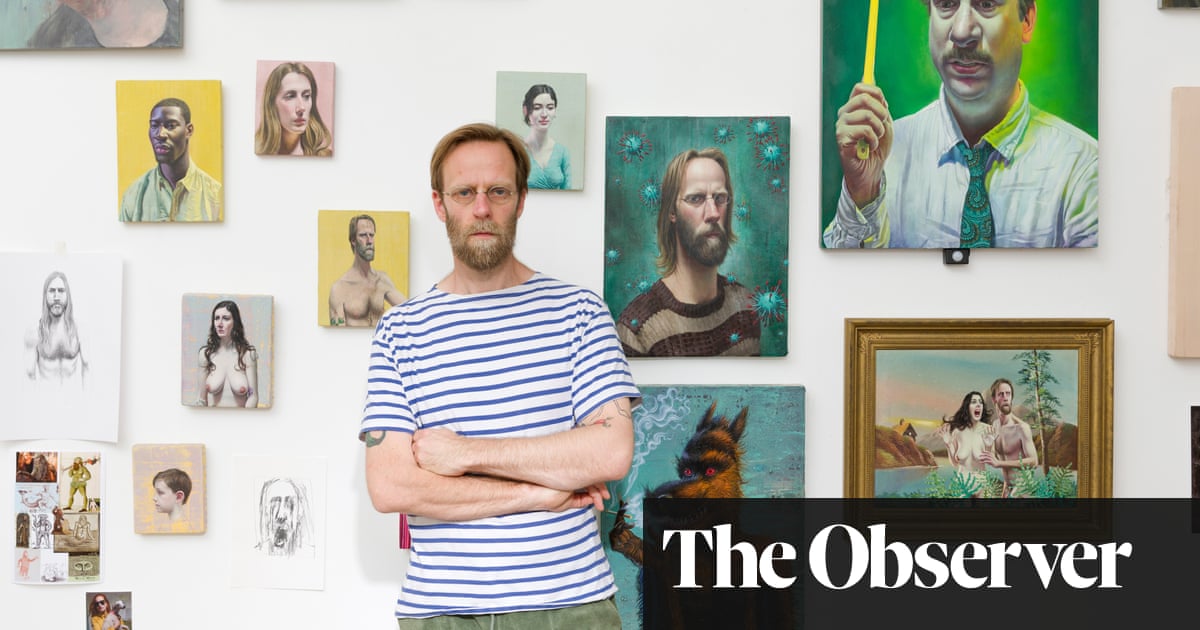
Agreat slobby lump of congealed black polyurethane foam slumps in a corner, its poured material arrested in mid-flow. There’s something irreducible about Lynda Benglis’s 1970 Untitled (Köln); it has an air of finality, art reduced to gravity and chemistry and formlessness.
The sculpture comes towards the end of Beyond Form: Lines of Abstraction 1950-70, which fills the galleries at Turner Contemporary. Before we get to Benglis, we’ve done a tour of postwar art, from the hurried lines and dots, smudges and scribbles of Indian artist Arpita Singh, like a furious glossolalia, and the rigorous, cool, systemic art of Gillian Wise and of Mary Martin, with their uninflected planes, their mirrors and rectangles of Perspex, their logic and their severe, mathematically derived constructions.
We’ve met a bulging wall of woven threads by Sheila Hicks and a spiky bronze relief called Katmandu by Dorothy Dehner, a work so redolent of the 1950s I feel I’ve gone back to my childhood. Something like a vase or a torso with unspeakable wounds and bits chewed out of it by shrapnel and a single glazed eye stares back at me, in a terracotta sculpture by Czech artist Daniela Vinopalová, and a worrying nest of phallic bulges poke out of their foreskins in a latex and plaster sculpture by Louise Bourgeois.
The title belies the ambition and scope of an exhibition that sprawls into the 70s, and which encompasses body parts, formal rigour and weirdness, the mathematical, the political, the woven, the painted, the cast, the constructed, the handmade and the machine assisted. The lines of abstraction go every which way. As curator Flavia Frigeri says, there is no such thing as pure form. All the work here was made by women, many of whom were marginalised or even excluded from an art world that was predominantly male, white and straight, and during a period when feminism was slowly gathering pace. Often their works were denigrated as craft or interior decoration both in the west and in the Soviet bloc – which also, perversely, gave female artists a certain freedom from the ideological constraints that controlled and censored artistic production in eastern Europe and the Soviet Union by not regarding it as art at all.
Slovakian artist Maria Bartuszová made sculptures that were used as teaching aids for visually impaired children, to help with their sensory awareness. Often she worked with balloons filled with liquid plaster, letting gravity dictate her forms. One here is like a single, giant raindrop in plaster, suspended from the ceiling like a weight on a plumb line. Nearby, a thin rubber tube drops to the floor from a lumpy black disc set into a black square hung on the wall. Snaking as it hits the ground, the tube seems to have purpose, like an insect’s proboscis, in one of two works by Eva Hesse. It is always good to see Hesse. In a second work, the discs have multiplied and become breast-like, and instead of rubber, grey rope coils on the floor. Do we need to know what this is? Does it have to be anything other than itself?
Heaped like spaghetti, a spotlit tangle of blue, yellow and silver aluminium tubing writhes in another corner. Claire Falkenstein’s Chain, made some time in the 1960s , twirls and pirouettes. As much drawing as sculpture, the LA-based artist’s work is as snaggly and abstract as string theory. Nearby, Brazilian Lygia Clark’s hinged shapes of sheet metal fold and open under glass on their plinths. Clark’s Bichos were meant to be manipulated by the viewer, their shapes always in flux and having no final form. Interacting with her work was meant to be in some way therapeutic. Now they’re inert under glass and can’t be handled.
A 1965 canvas by Agnes Martin, which is covered in a grid drawn in faint red colouring pencil, overdrawn with graphite pencil lines, is rendered all but invisible behind glass. The whole thing should hum, but the delicate, evanescent overall effect, made with extremely limited self-imposed means, (which is the entire point of Martin’s work) is completely lost to the ambient reflections. But that’s exhibition-making for you. Curators, like artists, must work with what’s available and what’s possible.
Marisa Merz worked in the kitchen on her monstrous, unwieldy 1966 Untitled (Living Sculpture), whose bashed-about aluminium pipes now writhe and twist and dangle from the ceiling like intestines in a butcher’s shop. She fashioned the tubes from strips of aluminium, cut and bent and stapled together on her kitchen table. The thing (what else might one call it?) was eventually suspended over the table, and later ended up slung from the ceiling of a local disco. Fabulous and grim, and sticky with the accumulated, accidental residues of cooking, and the smoke of the nightclub, it now belongs to Tate, to be worried over by conservators. The sculpture’s everyday origins give it a certain grandeur – and looking up, you can’t see the spatters or the grime.
One of the great pleasures here is the variety of approaches to materials and their handling. As varied and broad as the show is, it is also able to accommodate Merz and Barbara Hepworth, Benglis and Elizabeth Frink, sisal and wire and gunk and bronze, weaving and glass and any number of oppositional approaches. The precision with which Bridget Riley made her early experiments with back and white grids, and the exactitude with which Martin and Wise made their mathematically derived constructions and reliefs could be seen as at odds with Hannah Wilke’s five Androgynous and Vaginal Sculptures, with their indeterminate terracotta forms that look as if they’ve been modelled in the palm of her hand.
Japanese American artist Ruth Asawa’s hanging form made by crocheted loops of brass wire feels as if it has grown organically rather than been made, and Italian artist Carla Accardi’s use of a clear plastic packaging material, which she stapled to a canvas and covered in hurried, rhythmic marks in black varnish, leaves the wooden stretcher visible behind the repeated strokes of varnish. As much as you look at it, you can watch how Accardi’s work was made, from inside to out. One thing leads to another here, and another and another. It keeps on coming, against the odds.
Beyond Form: Lines of Abstraction, 1950-1970 is at Turner Contemporary, Margate, until 6 May












